You are here:
News & Events
- Winter 2008
- Summer 2008
- Winter 2007
- Spring 2007
- Summer 2006
- Summer 2005
- Fall 2004
- Winter 2003/2004
- Summer 2003
- Winter 2002/2003
- Fall 2002
- Spring 2002
- Fall/Winter 2001
- Spring 2001
- Fall 2000
- Summer 2000

A newsletter for patients of the Intramural Research Program (IRP), National Institute of Arthritis and Musculoskeletal and Skin Diseases (NIAMS)
Inside This Issue:
- From the Scientific and Clinical Directors
- NIAMS Names Dr. Robert Carter Deputy Director
- Cardozo Patients Come to NIH for Special Clinical Needs
- NIAMS IRP Research in the News
- NIAMS HPP Spotlight: Asian American Health Initiative
- NIAMS Hosts Joint Scientific Meeting
- NIAMS Introduces Bone Health Brochure for Multicultural Communities
- NIH ORBD˜NRC Releases 2009 Pocket Planner
- NIH ORBD˜NRC Releases Chinese- Language "People’s Piece"
- NIH Launches Undiagnosed Diseases Program
Researcher’s Talents and Heritage Make Her a Unique Asset to NIAMS
Sophia Cleland started working at the NIAMS Autoimmunity Branch in 2007 as part of the George Washington University Graduate Partnership Program. Sophia is currently completing her Ph.D. in immunology and will receive funding from NIAMS until 2010.
Sophia grew up in Phoenix, Arizona. Her mother, a Montana Sioux Indian, used to take Sophia and her siblings to spend the summers at the Fort Peck Assiniboine and Sioux reservation in Wolf Point, Montana. What Sophia saw and experienced at the reservation had a profound effect on the career path she chose.
Her family’s reservation sits atop an oil reservoir, and the extraction of oil there has resulted in severe ecological problems. “I noticed the drinking water had a layer of oil floating on top. Sometimes it looked yellow or red. I just wanted to do something about it after a while,” shared Sophia.
Her life in Phoenix was a stark contrast. "Although I lived in a neighborhood that was much poorer than the neighborhood to which I was bused," Sophia added, "I realized that I had a lot of opportunities that people back home on the reservation didn’t have, like access to a good education." This made Sophia very determined to take advantage of the resources she had available to her. Although her parents encouraged her to pursue studies in law or medicine, Sophia became interested in science. Her father, a California Mission Indian, was an electrical engineer, so she was exposed to science at an early age. She hoped that scientific research would allow her to find solutions to the problems plaguing people in Indian Country, particularly ecological issues.
Sophia’s first exposure to research was in her undergraduate studies as a chemistry major at Arizona State University. She rotated through various labs by taking advantage of several research programs associated with the National Science Foundation, the Howard Hughes Medical Institute, and NIH. These experiences increased her appreciation for scientific research, particularly population genetics, which Sophia felt would help address her questions about the diseases and problems that disproportionately affect Native Americans.
Sophia decided to pursue a master’s degree at Cornell University in Ithaca, New York, after graduating from Arizona State. She was the first person in her family to attend an Ivy League school. Also, only one in four Native Americans who study genetics do so at a level beyond an undergraduate degree. "I felt a huge responsibility when I realized how unique I am," said Sophia. "I felt I had to be very outspoken and be persistent with my ideas so people would listen."
Sophia attempted to do genetic research with Native American communities while at Cornell; however, at the time, she could not find the mentoring support necessary to fulfill the goal of following through on the research. This challenge fueled her fire even more.
Sophia came across an opportunity at the University of Oklahoma to conduct research on Native populations. Her main project focused on studying the genetic polymorphisms that may cause the severity of rheumatic diseases in Native American communities, which are greater than in other racial and ethnic populations. Sophia faced several roadblocks while conducting research in Indian Country, ranging from lack of resources to complications in the relationships among tribal, scientific, and university interests. These limitations made her even more determined to pursue her dreams of becoming a scientist. Sophia felt that something needed to be done about the pollution, the exploitation, and the social and medical problems that exist in Indian Country. She added, "I wanted to become a person of scientific authority so that I could say this is a real problem that needs to be addressed, because I did not see anyone else addressing it."
The limitations Sophia faced in Oklahoma prompted her to pursue an academic career in immunology. "I couldn’t address all the questions I had, so I got interested in the cellular and molecular mechanisms of the immune system." She believes that the search for novel polymorphisms will significantly contribute to the development of individualized medicine.
Sophia is now completing her Ph.D. in immunology at George Washington University while working at the NIAMS Autoimmunity Branch with Richard Siegel, M.D., Ph.D. Her research focuses on how CD4+ T cell death may impact autoimmunity. Sophia is very appreciative of the support she receives at NIH. "Coming to NIH has exposed me to the top level of scientists in the world. There is no place like it anywhere," she mused. "I especially love how the high level of scientific and cultural diversity here leads to a higher degree of the transfer of information than I have seen in other institutions. I am always excited each day that I come to the lab because I know this is the place where most of the scientific developments in the world have been born." ![]()
— by Sara Rosario Wilson
From the Scientific and Clinical Directors
We are pleased to bring you the Winter 2008 issue of IRPartners. In this issue, you’ll learn about NIH’s newly launched Undiagnosed Diseases Program, a clinical research program developed for people with mysterious conditions that have long eluded diagnosis.
In addition, you’ll get an inside look at how patients enrolled at the NIAMS Community Health Center/Cardozo Clinic receive care at the NIH Clinical Center. We also feature NIAMS staff members and student interns who were recently honored and a synopsis of IRP research highlights from the past several months.
Our NIAMS HPP Spotlight features the Montgomery County Asian American Health Initiative. Lastly, we introduce you to an individual who recently joined the NIAMS staff and several new health information resources.
We hope you enjoy this issue, and we look forward to sharing future highlights and advances with you.
|
|
|
|
NIAMS Names Dr. Robert Carter Deputy Director
 Dr. Robert Carter
Dr. Robert Carter
Robert H. Carter, M.D., former director of the Division of Clinical Immunology and Rheumatology at the University of Alabama at Birmingham (UAB), has been selected as deputy director of NIAMS. Dr. Carter assumed his official responsibilities October 1, 2008.
As deputy director, Dr. Carter will assist NIAMS director Stephen I. Katz, M.D., Ph.D., in providing strong and visionary leadership to the Institute, which is dedicated to a national innovative research program in diseases of bones, joints, muscles, and skin. In addition, he will contribute to NIAMS’ pursuit of cutting-edge research on a broad spectrum of investigations, from basic science to clinical studies, with translational research as a particular area of interest.
Board-certified in rheumatology and internal medicine, Dr. Carter has an established record of exemplary career achievements in the fields of rheumatology and immunology. Specifically, he and his colleagues have been leaders in contributing to the understanding of molecular regulation of B lymphocyte activation to identify targets for therapeutic control of autoantibody production. A major focus of his work has been on signal transduction by the B cell surface molecule CD19.
"I am delighted to welcome Dr. Carter to NIAMS," said Dr. Katz. "His stellar credentials as a scientist and his broad experience in NIH extramural activities will contribute to NIAMS’ long history of excellence in biomedical research." ![]()
Cardozo Patients Come to NIH for Special Clinical Needs
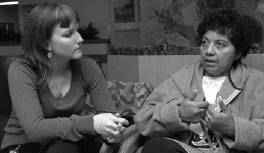 Former patient liaison Jennifer Walters (left) discusses the logistics of her visit with patient Maria Quevedo (right).
Former patient liaison Jennifer Walters (left) discusses the logistics of her visit with patient Maria Quevedo (right).
In 2001, the NIAMS Health Partnership Program (HPP) established a site in the Upper Cardozo Community Health Center of Unity Health Care, Inc., in Washington, D.C. The NIAMS Community Health Center (CHC) is an extension of the Institute’s clinical program on the NIH campus. Through the program, NIH has enrolled, treated, and referred patients to clinical research protocols; trained students and fellows; developed and disseminated English- and Spanish-language health education materials; and written and presented research papers, abstracts, and posters at the local and national level.
Still, there is more work to do. HPP is now wrapping up a 5-year plan to address goals and objectives. "The HPP continues to grow by extending the partnership to other sectors of the community while strengthening relationships, promoting new community research at the CHC, and developing new publications," said Daniel Kastner, M.D., Ph.D., clinical director of the Intramural Research Program (IRP) at NIAMS.
NIH staff members shared the lessons they’ve learned from their ongoing relationship with HPP partners through many presentations and publications in the hopes of assisting other community-based research programs. Many health professionals in and outside the Washington metropolitan area benefited from this sharing of expertise on how to set up a clinic in an underserved neighborhood, how to form community partnerships, how to evaluate research programs, and how to develop effective health education materials.
The Cardozo neighborhood is also changing. Like several other neighborhoods in the District, Columbia Heights is in the midst of a dramatic revitalization process. In some cases, new commercial development and condominium buildings are pushing long-term residents, many of them minorities, out of their rental units and away from the faith and social communities that made the area their home. According to NIH program organizers, those networks were an important reason for locating the CHC in this neighborhood. As these residents are displaced to suburbs, questions arise about whether these patients will return to the CHC and how the demographics of the clinic will change.
"The good thing is the clinic is next to the Metro. The bad thing is people tend to seek medical care close to their homes," said Barbara Mittleman, M.D., former NIAMS director of scientific interchange and current director of the NIH Office of Science Policy’s public-private partnership program.
One way NIH has met patients where they live is through its satellite center in the Congress Heights neighborhood of southeast Washington. According to Dr. Mittleman, the patient population seeking primary care at this Unity Health Care clinic is almost entirely African American and has very limited access to health services for subspecialty care. Dr. Mittleman and a NIAMS fellow visit Congress Heights every other week to see patients referred by their primary care physicians for potential rheumatic disease problems. She often refers those eligible for enrollment to the protocol under way at the CHC and offers advice to their doctors. "Some of these patients have never been to northwest D.C., let alone NIH in Bethesda," said Dr. Mittleman.
Another way that the NIAMS community has addressed transportation and logistical concerns is to bring CHC patients to NIH when necessary. Patients are transported to the NIH Clinical Center every Tuesday for access to the state-of-the-art technologies, therapies, and medications that are unavailable at the neighborhood clinic. A fully bilingual patient liaison accompanies the visiting patients during their time at the Clinical Center and serves as a valuable resource and advocate throughout the day.
On one typical Tuesday, five CHC patients are visiting the NIH Clinical Center. Only one speaks English, so the four Spanish speakers rely on former NIAMS patient liaison Jennifer Walters to translate the logistics of their visit and a Clinical Center volunteer, certified as a Spanish-language interpreter, for their medical interactions. A possible reflection of the evolving Cardozo area, only one of the five lives in the CHC neighborhood; the rest live in Silver Spring or Langley Park, Maryland, which also have large Hispanic communities. All the patients have rheumatic diseases and say that the treatments they’ve received through the CHC helped their conditions to improve. Most of them heard about the clinic through friends and, because of their positive experiences, would recommend that others they know participate in research. For local resident Maria Quevedo, the opportunity to receive no-cost medical care from a place as well known as NIH factored into her decision.
"Bringing NIH to them is an important way that NIH can reach out to these populations," said Dr. Christine Grady, head of the Section on Human Subjects Research in the Clinical Center Department of Bioethics. "In addition to providing access to diagnostic and treatment services, coming to campus helps bridge the cultural divide. People see what happens here, and they’ll go back to their community and talk to their friends and family about it." ![]()
This story was excerpted from an article by Jenny Haliski in the June 2008 issue of NIH’s Clinical Center News.
NIAMS IRP Research in the News
NIH Scientists Find a Novel Mechanism That Controls the Development of Autoimmunity
Intramural Research Program Scientific Director John O’Shea, M.D., and other investigators from the NIAMS Molecular Immunology and Inflammation Branch recently discovered that eliminating a protein called furin from immune cells in mice can lead to the development of autoimmune disease. The work, published in Nature, was the result of collaboration between NIAMS and the National Institute of Allergy and Infectious Diseases (NIAID). Because of furin’s known role in a wide range of diseases, other research teams are exploring the therapeutic potential of furin-blocking drugs. This NIAMS/NIAID discovery suggests that the development of such drug interventions could have the unexpected side effect of increasing the risk of autoimmune disease.
Pesu M, et al. T-cell-expressed proprotein convertase furin is essential for maintenance of peripheral immune tolerance. Nature 2008;455(7210):246–250.
NIAMS Scientists Find Potential New Way to Block Inflammation in Autoimmune Disease
Richard Siegel, M.D., Ph.D., and his colleagues in the NIAMS Immunoregulation Group have identified a promising new target for autoimmune disease treatment — a cell surface receptor called DR3. The scientists’ findings, published in Immunity, suggest that blocking this receptor could slow or stop the damaging inflammation characteristic of autoimmune diseases, potentially without leaving the body vulnerable to serious infections, as many current therapies do. The NIAMS group collaborated with a laboratory in Cardiff, Wales, which had generated genetically engineered mice deficient in DR3, as well as with a research group at the National Institute of Allergy and Infectious Diseases, which has developed mouse models of disease with strong T cell components, such as asthma and multiple sclerosis.
Meylan F, et al. The TNF-family receptor DR3 is essential for diverse T cell-mediated inflammatory diseases. Immunity 2008;29(1):79–89.
Molecular Pathway in Muscle Helps Explain Effectiveness of Diabetes Interventions
Under the direction of chief Vittorio Sartorelli, M.D., scientists at the NIAMS Laboratory of Muscle Stem Cells and Gene Regulation demonstrated for the first time in a mouse model that skeletal muscle cells cultured in a low-calorie environment are unable to grow into mature muscle cells. They also described for the first time the molecular pathway involving the protein SIRT1 that becomes activated in mouse skeletal muscle cells when they receive fewer calories. Their work, published in Developmental Cell, shows that SIRT1 is a molecule that allows skeletal muscle to read a low amount of nutrients in the environment and suppress genes that promote cell differentiation, thereby conserving energy. This research also demonstrates that two interventions that can control diabetes — reduced caloric intake and metformin — both target SIRT1.
Fulco M, et al. Glucose restriction inhibits skeletal myoblast differentiation by activating SIRT1 through AMPK-mediated regulation of Nampt. Developmental Cell 2008;14(5):661–673.
Vitamin A and Anti-Inflammatory Activity
John O’Shea, M.D., Arian Laurence, Ph.D., and their colleagues in the NIAMS Molecular Immunology and Inflammation Branch recently discovered how retinoic acid signaling can promote or suppress the activity of helper T cells, a class of immune cells involved in inflammatory responses. Understanding how the newly discovered mechanism regulates the balance between two kinds of helper T cells — pro-inflammatory Th17 cells and anti-inflammatory T regulatory cells — could eventually yield benefits for people with autoimmune disease. The work, which appeared in the February 2008 issue of Blood, was a collaborative effort of NIAMS, the National Institute of Allergy and Infectious Diseases, and the Howard Hughes Medical Institute.
Elias K, et al. Retinoic acid inhibits Th17 polarization and enhances FoxP3 expression through a
Stat-3/Stat-5 independent signaling pathway. Blood 2008;111:1013–1020.![]()
NIAMS HPP Spotlight: Asian American Health Initiative

The Asian American Health Initiative (AAHI), part of the Montgomery County Department of Health and Human Services in Maryland, was established in 2005 to help eliminate health disparities that exist between Asian Americans and their non-Asian counterparts. It is the first health-related program that directly addresses the diverse Asian American communities in Maryland. AAHI’s mission is to identify the health care needs of Asian American communities, to develop culturally competent health care services, and to implement health education programs that are accessible and available to all Asian Americans in the county. According to a recent survey, 13.3 percent of Montgomery County residents identified themselves as Asian American. It is one of the fastest growing populations in the county.
Although AAHI has a small staff of five, it has successfully developed several education and outreach services for Asian Americans. Programs include screenings for cancer, hepatitis B, and osteoporosis, as well as education. AAHI works through its Health Promoters Program to reach and teach diverse Asian American subgroups about these health topics. AAHI trains people to become lay health educators in their communities, thereby bridging the language and cultural divide. NIAMS recently collaborated with AAHI to train health promoters about osteoporosis and bone health.
In addition, the Institute has partnered with AAHI to offer culturally and linguistically appropriate education materials for distribution at Asian outreach events and is working with AAHI to develop educational materials in other Asian languages.
"NIAMS is a valuable partner that not only conducts research at the Federal level, but is also a comprehensive program that supports local partners at the community level to reduce bone, joint, muscle, and skin disease-related disparities," said Perry Chan, program assistant at AAHI. AAHI has worked closely with the Institute since 2007 as a partner in the Health Partnership Program (HPP).
To learn more about Montgomery County’s Asian American Health Initiative, please visit http://www.aahiinfo.org. ![]()
NIAMS Hosts Joint Scientific Meeting
NIAMS, the NIH Office of Rare Diseases (ORD), and the National Institute of Allergy and Infectious Diseases (NIAID) recently cosponsored a meeting, “New Therapies for Chronic Recurrent Osteomyelitis (CRMO), Synovitis, Acne, Pustulosis, Hyperostosis, and Osteitis (SAPHO) Syndrome as well as Behçet’s Disease Through Understanding the Pathogenesis.” Held in early September on the NIH campus, the meeting served as a launch pad for the development of a research program focused on the application of current technology to better understand the origin and development of these diseases. Organizers included (below, from left to right), Karyl Barron, M.D. (NIAID), Daniel Kastner, M.D., Ph.D. (NIAMS), Stephen Groft, Pharm.D. (ORD), Raphaela Goldbach-Mansky, M.D. (NIAMS), Polly Ferguson, M.D. (University of Iowa), and Ahmet Gül, M.D. (Istanbul University). ![]()
 Organizers of the NIH meeting on therapies for CRMO, SAPHO, and Behçet’s disease
Organizers of the NIH meeting on therapies for CRMO, SAPHO, and Behçet’s diseaseNIAMS Introduces Bone Health Brochure for Multicultural Communities

Bone Health for Life: Easy-to-Read Information for Patients and Families is an illustrated 20-page booklet that focuses on osteoporosis, a “silent” disease in which bones become weak and more likely to break. Bone Health for Life provides readers with valuable information and describes strategies to improve bone health at any age. Topics include:
- Why does bone health matter?
- What factors increase the chances of developing osteoporosis?
- What lifestyle approaches can help to promote bone health for life?
Bone Health for Life is available in PDF and PowerPoint versions on the NIAMS Web site (http://www.niams.nih.gov/Health_Info/Bone/Bone_Health/bone_health_for_life.asp). Free copies are available to anyone on request. Health care providers, community centers, and others involved with health promotion may be interested in ordering multiple copies to give to patients and distribute at community health events. To order, please contact the NIH Osteoporosis and Related Bone Diseases ~ National Resource Center at 800–624–2663 or use the order form at http://catalog.niams.nih.gov/. ![]()
NIH ORBD~NRC Releases 2009 Pocket Planner
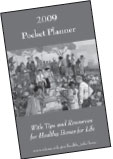
Because of the enthusiastic response to the 2008 Pocket Planner With Tips and Resources for Healthy Bones for Life, the NIH Osteoporosis and Related Bone Diseases ~ National Resource Center (NIH ORBD~NRC) has launched a new edition of this resource for 2009. The planner provides simple tips for improving bone health and provides links to Federal resources and more detailed information on the NRC Web pages.
Each month of the planner offers a unique strategy for enhancing bone health, such as:
- Getting enough calcium and vitamin D
- Staying active for strong bones
- Talking to your health care provider about your bones
- Preventing falls that break bones.
The planner includes space to plan activities for optimizing bone health as well as a list of selected calcium-rich foods and their calcium content.
Free planners are available in quantities up to 25. To order, please contact the NRC at 800–624–2663 or use the order form online at http://catalog.niams.nih.gov/.![]()
NIH ORBD~NRC Releases Chinese-Language "People’s Piece"
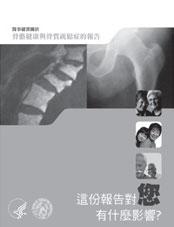
As part of its ongoing effort to provide culturally relevant health information to diverse audiences, the NIH Osteoporosis and Related Bone Diseases ˜ National Resource Center (NIH ORBD~NRC) recently released a Chinese-language version of The Surgeon General’s Report on Bone Health and Osteoporosis: What It Means to You. Commonly known as "The People’s Piece," this popular award-winning publication for consumers is also available in English and Spanish.
Following input from Chinese American individuals, health professionals, and communications specialists, the NIH ORBD˜NRC transadapted the original English "People’s Piece" to include new photos and relevant text for Chinese American audiences.
The publication provides essential information on bone health, including:
- Why healthy bones are important
- Risk factors for osteoporosis
- Strategies to enhance bone health
- How to prevent falls
- Tips for talking to your doctor.
The brochure is available at no charge. To order by phone or to inquire about bulk orders for health forums or fairs, please contact the NIH ORBD˜NRC at 800–624–BONE (2663) or NIAMSBoneInfo@mail.nih.gov. ![]()
NIH Launches Undiagnosed Diseases Program
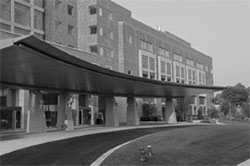
NIH has established a new clinical research program that aims to provide answers to patients with mysterious conditions that have long eluded diagnosis. Called the Undiagnosed Diseases Program, the trans-NIH initiative focuses on the most puzzling medical cases referred to the NIH Clinical Center in Bethesda, Maryland, by physicians across the Nation.
To evaluate each patient enrolled in the new program, NIH has enlisted the expertise of more than 25 of its senior attending physicians, whose specialties include endocrinology, immunology, oncology, dermatology, dentistry, cardiology, and genetics. William A. Gahl, M.D., Ph.D., an expert on rare genetic diseases, serves as director of the new program, and two nurse practitioners manage patient recruitment and logistics. The program uses existing facilities and staff already at the NIH Clinical Center, the National Human Genome Research Institute, and the NIH Office of Rare Diseases.
To be considered for this NIH pilot program, a patient must be referred by a physician and provide all medical records and diagnostic test results requested by NIH. Patients who meet the program’s criteria (as many as 100 each year) will be asked to undergo additional evaluation during a visit to the NIH Clinical Center that may take up to a week.
Information specialists at the Clinical Center’s Patient Recruitment Call Center (866–444–8806) can provide more information about eligibility and what kinds of medical information referring physicians must submit for review by the Undiagnosed Diseases Program’s medical team. (Individuals or their health care providers can call the Center.) ![]()
Office of Communications and Public Liaison
National Institute of Arthritis and Musculoskeletal and Skin Diseases (NIAMS)
National Institutes of Health
Building 31/Room 4C02
31 Center Drive, MSC 2350,
Bethesda, MD 20892-2350
Phone: 301-496-8190
TTY: 301-565-2966
Fax: 301-480-2814
Email: niamsinfo@mail.nih.gov
Website: http://www.niams.nih.gov/
National Institute of Arthritis and Musculoskeletal and Skin Diseases (NIAMS)
Information Clearinghouse
National Institutes of Health
1 AMS Circle
Bethesda, MD 20892-3675
Phone: 301-495-4484
Toll Free: 877-22-NIAMS (226-4267)
TTY: 301–565–2966
Fax: 301-718-6366
Email: NIAMSinfo@mail.nih.gov
Website: http://www.niams.nih.gov
Stephen I. Katz, M.D., Ph.D., Director
John O’Shea, M.D., Scientific Director
Daniel Kastner, M.D., Ph.D., Clinical Director
Janet S. Austin, Ph.D., OCPL Director
Marcia Vital, M.S., Editor
Trish Reynolds, R.N., M.S., Associate Editor
Contributors:
Mimi Lising, M.P.H., Sara Rosario Wilson

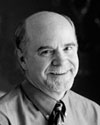 John O’Shea, M.D.
John O’Shea, M.D. Daniel Kastner, M.D., Ph.D.
Daniel Kastner, M.D., Ph.D.

